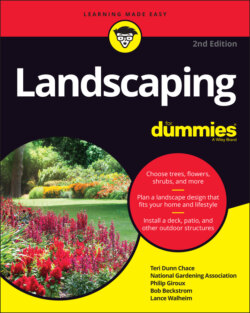Читать книгу Landscaping For Dummies - Lance Walheim - Страница 30
Drawing your site analysis
ОглавлениеStick to these steps as you draw your site analysis:
1 Get a sheet of paper and a pencil and sketch your existing property.Include your house with windows and doors, existing plants, and general north/south directions. Although you should try to draw to scale, your rough drawing doesn’t have to be very precise.
2 Go outside and put the drawing on a clipboard and walk around your yard, making notations of the following:Sun and shade: Mark areas that are sunny or shady, and at what times of the day.Views: Note good and bad views — ones that you may want to preserve and ones you may want to block.Good views — surrounding hills, the coast, maybe just the nearby skyline — are easy to recognize.Bad views, on the other hand, take a little more eyeballing. For instance, determine whether the neighbors can see in your yard or you can see in theirs, or whether you feel the need to block your view of their garage or old-car collection. Determine whether you have things on your own property, like a utility or storage area, that you’d rather not see. Figure out what you’ll see if you put in a raised deck. Look to see whether utility poles are visible. Check how the view changes when deciduous trees lose their leaves.Prevailing winds: Note if you regularly feel winds that you may be able to block with fencing or plants.Slope and drainage: Put in some arrows that give you a rough idea of the contours of your yard. Sloping ground or uneven terrain can be an interesting part of a landscape, especially if you accentuate it with walls or plants combined with stone to simulate a dry streambed. High points may also provide some views that you want to take advantage of.On the other hand, sloping ground can also mean erosion or drainage problems that can threaten your house or yard. Be sure that water drains away from all the walls of your house. Mark down any areas that seem overly wet or where moss or algae is growing. If you can stand getting wet, go outside in a rainstorm and watch where excess water flows. Just don’t take your clipboard with you! Chances are, your landscape isn’t isolated, which means that changes you make can adversely affect a neighbor’s property. Routing your drainage off your land and onto theirs isn’t the answer (and of course, not a recipe for neighborhood harmony — no holiday card!). So, too, can your alterations lead to erosion beyond your property lines. Therefore, you must work to avoid such scenarios and find solutions that work within your own property. If the situation is daunting, seek advice/help from a professional.Existing plants: Draw in large trees, shrubs, vines, and perennials that you may want to preserve. (Leave out or cross off ones that you mean to get rid of.)Interesting natural features: A small stream or handsome rocks protruding from the ground can become special landscape features.Noise, smells, and lights: Let your senses go and write down anything else that you notice — lights at night, noise from next door, and even unpleasant odors. You may be able to do something about them.Winter sights and sounds: Look to see whether your plants are getting crushed by snow under the eaves. Determine where you put the snow when shoveling or snowblowing, or where a snowplow shoves piles. Be sure to avoid planting or installing seating in those areas.Do this over a period of several days, at different times of the day. Doing so will give you an opportunity to observe your landscape better or more completely than you perhaps ever have before. In particular, notice when the sun shines (or doesn’t) in different areas and for how long. Does your yard have microclimates? Many do! This term refers to a spot that has different and unique conditions, compared to the rest of your landscape. Instead of struggling to alter its natural inclinations, we suggest you capitalize on them. To do so, for example, find moisture-loving plants for a soggy spot. Place a comfy chair in the perpetually shady corner, and put in ferns and other shade-loving plants around it.
3 Make notations of what you see from inside the house including:Views: Note the good views and the bad. Look out your windows; what do you see? A nice view of the yard or the neighbors’ back porch? Determine who can see in the windows from the street or next door.Sunlight: Note whether the sun blazes through your windows, heating the house in the afternoon. Or perhaps you get a pleasant light that’s cast on the kitchen table as you drink coffee in the morning.Lights: Observe whether car lights or signs shine through your window at night. (Ask yourself if a tree or even a vine-covered trellis could block that problem.)
4 Where applicable, consider the needs outlined in the section, “Drawing within the Lines: Living with Practical Issues,” earlier in this chapter.Note whether you’re already accommodating these needs. Are you satisfied/happy? Can you reserve or even add space?
